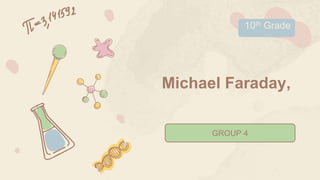
SCIENCE GROUP 4 - MICHAEL FARADAY.pptx
- 1. Michael Faraday, GROUP 4 10th Grade
- 2. Michael Faraday Michael Faraday was a French physicist and chemist who is best known for his discoveries of electromagnetic induction and of the laws of electrolysis. His biggest breakthrough in electricity was his invention of the electric motor. (1791 – 1867)
- 3. Apprenticeships and Early Studies in Electricity Humphry Davy was one of the leading chemists of the day when Michael Faraday joined him in 1812, having discovered sodium and potassium and studying the decomposition of muriatic (hydrochloric) acid that yielded the discovery of chlorine. Davy and Faraday began to interpret the molecular structure of such chemicals, which would greatly influence Faraday's ideas about electricity.
- 4. When Michael Faraday's second apprenticeship under Humphry Davy ended in late 1820, Faraday knew about as much chemistry as anyone else at the time, and he used this newfound knowledge to continue experiments in the fields of electricity and chemistry. Apprenticeships and Early Studies in Electricity
- 5. Michael Faraday is best known for his work regarding electricity and magnetism. He built two devices to produce what he called "electromagnetic rotations". One of these, now known as the homopolar motor, caused a continuous circular motion that was engendered by the circular magnetic force around a wire that extended into a pool of mercury wherein was placed a magnet; the wire would then rotate around the magnet if supplied with current from a chemical battery.
- 6. Electromagnetic rotation experiment of Faraday, 1821, the first demonstration of the conversion of electrical energy into motion
- 7. Homopolar motor A homopolar motor is a direct current electric motor with two magnetic poles, the conductors of which always cut unidirectional lines of magnetic flux by rotating a conductor around a fixed axis so that the conductor is at right angles to a static magnetic field.
- 8. One of Michael Faraday first experiments after discovering electromagnetic rotation was attempting to pass a ray of polarized light through an electrochemically decomposing solution to detect the intermolecular strains the current would produce. However, throughout the 1820s, repeated experiments yielded no results. It would be another 10 years before Faraday made a huge breakthrough in chemistry.
- 10. Michael Faraday carried out numerous experiments to prove that electricity could be generated from magnetism. He not only demonstrated electromagnetic induction, but also developed a good conception of the processes involved. Electromagnetic or magnetic induction is the production of an electromotive force (emf) across an electrical conductor in a changing magnetic field.
- 11. One of the experiments performed by Faraday in that important year featured a permanent magnet and a galvanometer connected to a coil of wire wound around a paper cylinder, similar to those illustrated in this tutorial. nationalmaglab.org/html5/MagLabU/source/electromagneticin duction/electromagneticinduction.html
- 12. In this demonstration of electromagnetic induction, the mechanical energy of the moving magnet is converted into electricity, because a moving magnetic field, entering a conductor, induces current to flow in the conductor.
- 13. Observe that the voltmeter linked to the coil only indicates the presence of a current when the magnet is actually in motion
- 14. magnetic field lines, depicted in blue, emanating from the magnet, and how the direction of the current (indicated in black arrows) changes depending on which way the magnet is moving. When the north end of the magnet enters the coil, a current is induced that travels around the coil in a counterclockwise direction; when the magnet is then pulled out of the coil, the direction reverses to clockwise.
- 15. the current produced is stronger when the magnet is moved quickly rather than gradually.
- 16. As indicated by the voltmeter, greater voltage can be induced in coils made from a larger number of turns of wire.
- 17. The homopolar generator, also called the Faraday disk is a DC electrical generator consisting of an electrically conductive disc or cylinder rotating in a plane perpendicular to a static magnetic field. The first homopolar generator was developed by Michael Faraday during his experiments in 1831 Homopolar Generator
- 18. How it works is two wires is attached through a sliding contact to a copper disc. By rotating the disc between the poles of a horseshoe magnet, he obtained a continuous direct current, creating the first generator. From his experiments came devices that led to the modern electric motor, generator, and transformer.
- 19. Diamagnetism In 1845, Faraday discovered that many materials exhibit a weak repulsion from a magnetic field: a phenomenon he termed diamagnetism are repelled by a magnetic field; an applied magnetic field creates an induced magnetic field in them in the opposite direction, causing a repulsive force. In contrast, paramagnetic and ferromagnetic materials are attracted by a magnetic field
- 20. Faraday Cage is an enclosure used to block electromagnetic fields. A Faraday shield may be formed by a continuous covering of conductive material, or in the case of a Faraday cage, by a mesh of such materials. Faraday cage was invented by Michael Faraday in 1836.
- 21. Michael Faraday continued his electrical experiments throughout much of his later life. In 1832, he proved that the electricity induced from a magnet, voltaic electricity produced by a battery, and static electricity were all the same. He also did significant work in electrochemistry, stating the First and Second Laws of Electrolysis, which laid the foundation for that field and another modern industry. He later died in August 25, 1867